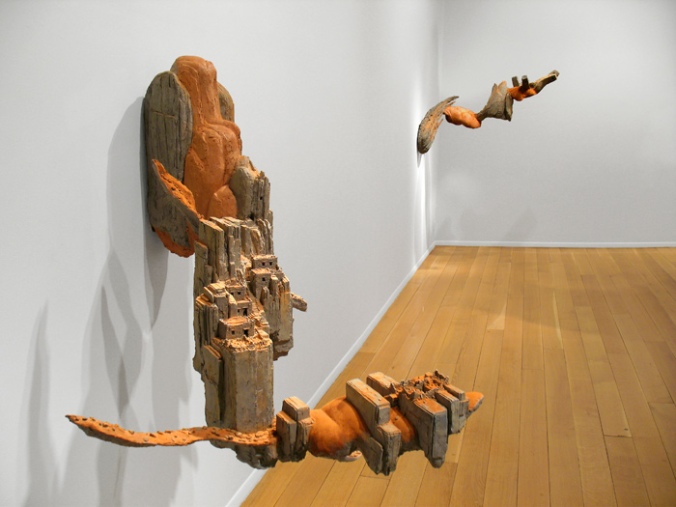On October 7, for this year’s inaugural Artists at the Institute lecture, Charles Simonds delivered an energetic and astute summation of his career to date. He began with his earliest Dwellings—miniature architectural structures, made of clay, sand, and small bits of wood—which in the early 1970s seemed to emerge organically from the gutters, broken walls, and empty lots of downtown New York, springing up wherever the city’s crumbling infrastructure afforded a place for their putative inhabitants, whom Simonds dubbed the “Little People.” Simonds’s rich practice, which incorporates elements of sculpture, architecture, urban planning, craft, performance, conceptualism, narrative fiction, and social engagement, has taken many forms in many places since those early breakthroughs. Yet even today, viewers seem perpetually drawn back to the original Dwellings, which remain landmarks of his artistic practice and of the downtown scene though they exist only in photographs and in memory.

There are many reasons for this consistent focus on Simonds’s early work, not least the powerful charm exerted on us by things that are gone. The Dwellings’ loss helps establish them as a kind of founding myth—both for Simonds’s mature work and for the narratives he wove within it. But at play here is also the art world’s typical exhaustion with itself, the self-disgust that has, since Duchamp, drawn art irresistibly toward things it hasn’t yet absorbed. For that reason viewers may think that the Dwellings’ natural habitat is the city, and the white walls of the museum can showcase only taxidermied specimens, removed from both context and life.
But the works by Simonds that we find indoors are not the same as those of the 1970s streets, and require a different mode of viewing. Even tucked away in the staircase, the Whitney’s site-specific 1981 Dwelling—the only work by Simonds most people have seen in the flesh—was made for an art space and demands to be understood in that context: as sculpture, as institutional intervention, and as in dialogue with the building and the other works of art that one finds there. This piece is one of three Dwellings the artist made as part of that commission: the other two adorn the architecture across the street. (The artist assured the audience that the Met has committed to preserving the installation when it takes over their Breuer building next year.)
In particular, Simonds’s work of the past fifteen years—graceful, dreamlike structures that float free of any geography, seeming to defy not only gravity but the terrestrial origin of their materials—suggest an entirely different set of concerns from their downtown cousins. Unlike the outdoor Dwellings, which appear to grow naturally from their sites, these recent structures lack a “substrate,” as Simonds put it, and thus a geographical or geopolitical context. A roomful of art historians might well have thought of Pannini or Piranesi, and the distinction between vedute (views of real places) and capricci (architectural fantasies). These freestanding, occasionally free-floating works are fantasies, and thus benefit from the disconnected dream landscape of the gallery.

At the end of Simonds’s formal presentation, one audience member asked him whether such freestanding sculptures—made to exist between four white walls—represent an abandonment of the values that drove the artist away from the art world in the first place. Simonds has fielded this question before—more often than his patient answer might suggest—and he responded with the sort of reasoned analysis that art history would have come up with already if it wasn’t so preoccupied with its own self-esteem issues.
Simonds reminded us, first of all, that he has always made sculpture; that even as he sought new audiences and interactions with his site-specific, outdoor Dwellings, he maintained a studio practice in order to remain in dialogue with the philosophical and artistic lines of inquiry that interested him. And like many of his friends and peers, his work tries to blur the lines between art and life, facture and growth. One reason Simonds went out into the street, then, was to see if he could work within that in-between place; something that, without the comfortable didactic frame of the gallery, could operate on viewers’ consciousness in a way that objects already labeled “art” could not.
If we ask how Simonds can legitimately make work for the art world’s white walls, that may be because we have lost the ability to see it—really see it—in any other context. We, denizens of the art world, are barred from that experience of uncertainty and wonder that is only fully available to someone who happens onto the work without a ready-made discourse for it. Before we dismiss Simonds’s freestanding sculptures, we should recognize that he has made them for us.


Be First to Comment